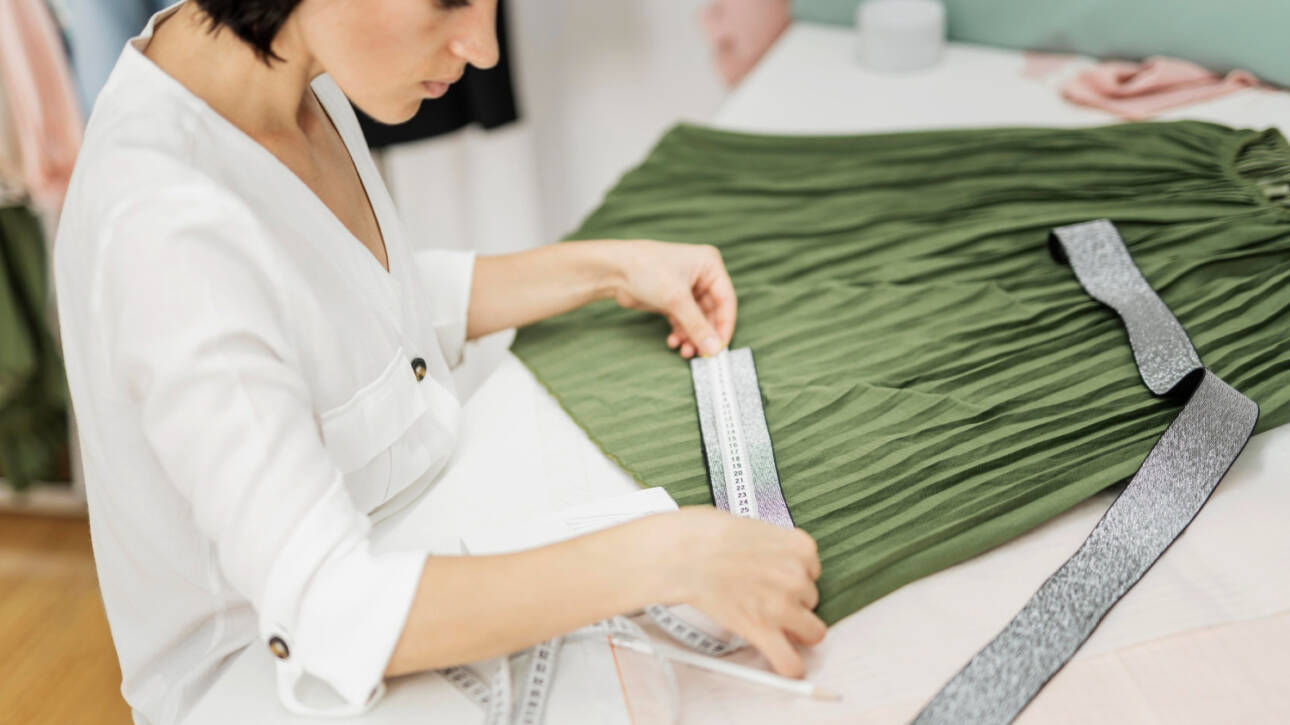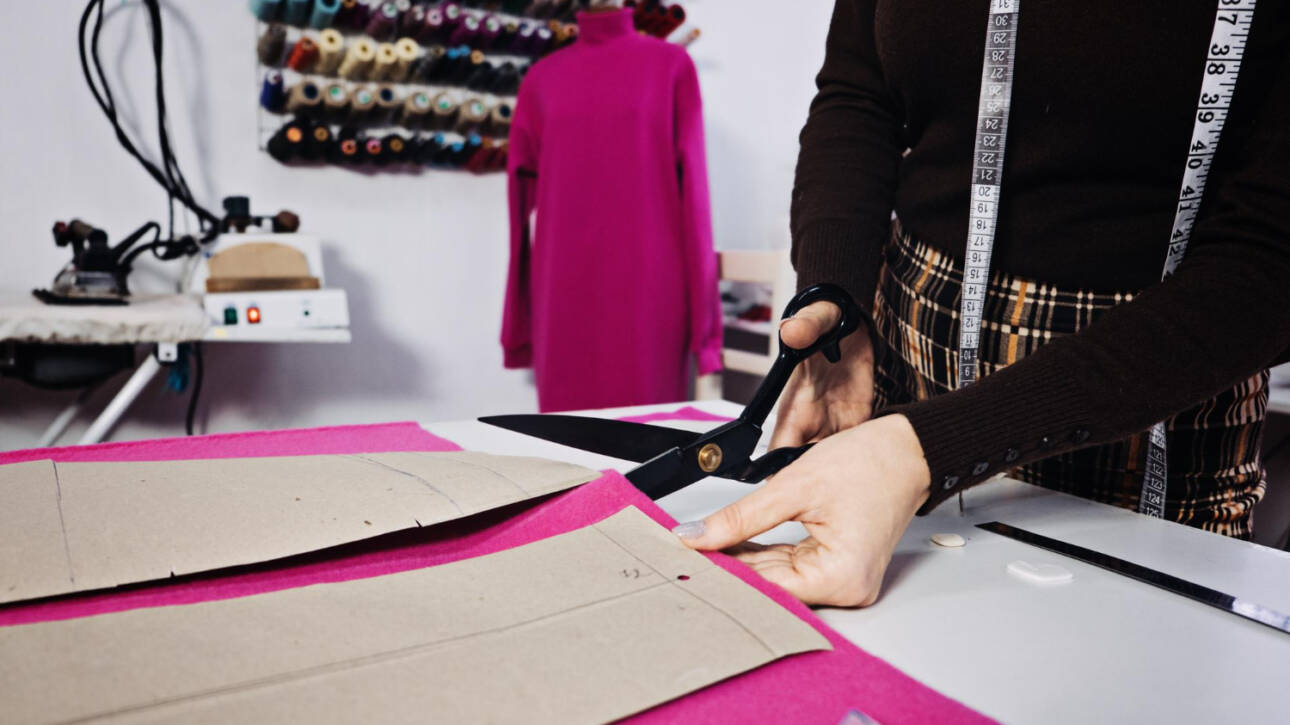PRODUCTION OF WOMEN SKIRTS
Producing women’s skirts involves a detailed process that combines creativity, technical expertise, and quality control. Here’s a step-by-step guide to the production process:
1. Design and Planning
• Market Research: Identify current trends, customer preferences, and competitor styles.
• Sketching: Designers create detailed sketches of the skirt, including elements like length, fit, fabric, and embellishments.
• Fabric Selection: Choose fabrics based on the style of the skirt (e.g., denim for casual skirts, silk for formal ones, tulle for romantic designs).
• Technical Specifications: Develop a tech pack that outlines measurements, construction details, and any special features like zippers, pleats, or embroidery.
2. Pattern Making
• Creating the Pattern: A pattern is developed for each piece of the skirt (e.g., waistband, panels, lining). This can be done manually or using CAD software.
• Grading: The pattern is adjusted for different sizes to ensure a consistent fit across all sizes.
3. Fabric Cutting
• Fabric Spreading: Lay the fabric flat in layers to ensure precise cutting.
• Cutting Process: Patterns are placed on the fabric, and cutting tools (manual scissors, electric cutters, or laser machines) are used to cut the pieces.
4. Sewing and Assembly
• Joining Pieces: Fabric pieces are sewn together in a specific order, starting with the skirt panels and moving to the waistband, zippers, or other closures.
• Special Features:
• Pleats or gathers may be added.
• Pockets, slits, or embellishments like buttons or embroidery are attached.
• Industrial Machines: Specialized sewing machines handle tasks like hemming, overlocking edges, and creating decorative stitching.
5. Finishing
• Ironing and Pressing: Skirts are pressed to create crisp pleats, smooth seams, and an overall polished appearance.
• Quality Checks: Inspect the skirts for flaws in stitching, fabric, or fit. Ensure zippers and buttons function properly.
• Labels and Tags: Attach care labels, size tags, and brand labels to the skirts.
6. Quality Control
• Fitting Tests: Skirts are tested on models or mannequins to ensure the design fits as intended.
• Durability Checks: Test for fabric strength, colorfastness, and seam integrity.
7. Packaging and Distribution
• Folding and Packing: Skirts are neatly folded and packed in protective packaging (e.g., polybags or boxes).
• Shipping: Finished products are shipped to retailers, wholesalers, or directly to customers.

Types of Skirts Produced
• Mini Skirts: Short skirts, often made from denim, leather, or cotton blends.
• Midi Skirts: Mid-length skirts, frequently pleated or flowy, made from fabrics like chiffon, silk, or polyester.
• Maxi Skirts: Long skirts, often made from lightweight fabrics for casual styles or heavier fabrics for formal occasions.
• Pencil Skirts: Fitted, knee-length skirts, typically made from structured fabrics like wool, polyester, or blends.
Sustainability in Skirt Production
• Eco-Friendly Fabrics: Use organic cotton, recycled polyester, or sustainable materials like bamboo.
• Ethical Practices: Ensure fair wages, safe working conditions, and minimal waste during production.
• Upcycling: Repurpose old garments or fabric scraps into new skirt designs.
Production Automation and Technology
• Digital Pattern Making: CAD software ensures precise pattern development and reduces material waste.
• Automated Cutting Machines: Improve speed and accuracy during the cutting process.
• 3D Virtual Sampling: Allows designers to visualize skirts without creating physical prototypes, saving time and resources.
Women’s skirt production is a dynamic process that blends traditional craftsmanship with modern technology, catering to various styles, occasions, and customer preferences.

WOMEN SKIRT COMBINATIONS
Women’s skirts are versatile and can be styled in countless ways for casual, formal, or party looks. Here are some stylish and practical skirt combinations for various occasions:
1. Mini Skirts
• Casual Look: Pair a denim mini skirt with a tucked-in graphic tee and white sneakers. Add a crossbody bag for a trendy vibe.
• Chic Look: Style a leather mini skirt with a fitted turtleneck and ankle boots. Accessorize with gold jewelry.
• Party Look: Combine a sequined mini skirt with a satin blouse and high heels for a glamorous outfit.
2. Midi Skirts
• Office Style: Wear a pleated midi skirt with a button-down shirt and pointed-toe flats. Add a blazer for extra polish.
• Casual Elegance: Pair a flowy midi skirt with a fitted tank top and sandals. Add a straw hat for a summer-ready look.
• Evening Look: Style a satin midi skirt with a lace camisole and strappy heels. Add a clutch for sophistication.
3. Maxi Skirts
• Boho Look: Match a tiered maxi skirt with a crochet top and gladiator sandals. Add layered necklaces for a bohemian vibe.
• Relaxed Style: Pair a flowy maxi skirt with a knotted graphic tee and sneakers.
• Formal Look: Wear a chiffon maxi skirt with a fitted blouse and heels for an elegant evening outfit.
4. Pencil Skirts
• Professional Look: Pair a high-waisted pencil skirt with a tailored blouse and pumps. Add a belt for a structured silhouette.
• Smart Casual: Wear a knit pencil skirt with a chunky sweater and ankle boots.
• Night Out: Combine a leather pencil skirt with an off-the-shoulder top and stilettos.
5. A-Line Skirts
• Retro Look: Pair an A-line skirt with a fitted cardigan and ballet flats for a vintage-inspired outfit.
• Modern Casual: Style an A-line skirt with a crop top and sneakers. Add a denim jacket for an extra layer.
• Formal Touch: Combine a printed A-line skirt with a silk blouse and kitten heels.
6. Wrap Skirts
• Beach Look: Wear a wrap skirt over a swimsuit with flip-flops and a straw tote.
• Day Out: Pair a printed wrap skirt with a simple tee and espadrilles.
• Evening Elegance: Style a satin wrap skirt with a fitted bodysuit and strappy sandals.
7. Pleated Skirts
• Sporty Look: Combine a pleated mini skirt with a polo shirt and sneakers for a preppy vibe.
• Office Style: Pair a pleated midi skirt with a tucked-in blouse and loafers.
• Party Look: Wear a metallic pleated skirt with a camisole and heels.
8. Denim Skirts
• Casual Look: Pair a denim skirt with a striped top and white sneakers. Add a backpack for a youthful vibe.
• Layered Look: Wear a denim skirt with a sweater and knee-high boots in colder weather.
• Edgy Style: Style a distressed denim skirt with a leather jacket and combat boots.
9. Tulle Skirts
• Romantic Look: Pair a tulle skirt with a lace top and ballet flats for a dreamy outfit.
• Modern Twist: Combine a tulle skirt with a graphic tee and ankle boots for an edgy yet feminine style.
• Formal Look: Wear a long tulle skirt with a fitted satin blouse and heels for a special occasion.
10. High-Waisted Skirts
• Crop Top Combo: Pair a high-waisted skirt with a crop top and sandals for a balanced silhouette.
• Tucked-In Look: Style a high-waisted skirt with a tucked-in button-down shirt and wedges.
• Winter Style: Wear a high-waisted skirt with a fitted turtleneck, tights, and knee-high boots.
Tips for Styling Skirts
• Balance Proportions: Pair fitted tops with flowy skirts and loose tops with more structured skirts.
• Accessorize: Use belts, bags, and jewelry to elevate your skirt outfits.
• Footwear: Choose shoes that complement the skirt length (e.g., ankle boots for midi skirts, heels for pencil skirts).
Skirts offer endless possibilities for creating outfits that suit your mood, style, and occasion!
HISTORY OF WOMEN SKIRTS
The history of women’s skirts spans centuries and reflects changes in culture, social norms, and fashion trends. Here’s an overview of how skirts have evolved over time:
1. Ancient Times: The Birth of the Skirt
• Universal Garment: Skirts were one of the earliest clothing forms, worn by both men and women in ancient cultures.
• Mesopotamia and Egypt: Women wore wraparound skirts made of woven fabric, often paired with belts. In Egypt, skirts were light and linen-based due to the warm climate.
• Greece and Rome: Women wore draped skirts as part of long tunics or dresses like the peplos and chiton, reflecting elegance and femininity.
2. Medieval Period (5th–15th Century)
• Layered Clothing: Women’s skirts were part of long gowns with layers of fabric for warmth and modesty.
• Status Symbol: Skirts made of luxurious fabrics like silk or velvet were reserved for the upper classes. Lower-class women wore simpler, coarse materials.
• Full-Length Styles: Skirts extended to the ground, as modesty was highly valued.
3. Renaissance (15th–17th Century)
• Structured Skirts: Skirts became wider and more elaborate, often worn over farthingales (hooped petticoats) to create a bell-shaped silhouette.
• Decoration: Embroidery, lace, and jewels adorned skirts, showcasing wealth and status.
• Layering: Multiple skirts or underskirts were layered to add volume and visual richness.
4. Baroque and Rococo Eras (17th–18th Century)
• Exaggerated Styles: The pannier (side hoops) created wide skirts that extended horizontally, popular in French court fashion.
• Fabrics and Patterns: Silks, brocades, and floral patterns became prevalent, reflecting the opulence of the era.
• Length Variations: While court skirts were long and dramatic, working-class women wore shorter, more practical skirts.
5. Victorian Era (19th Century)
• Crinolines and Bustles:
• The crinoline cage (mid-1800s) made skirts extremely wide.
• By the late 1800s, bustles replaced crinolines, emphasizing the back of the skirt with draping and padding.
• Fabric Layers: Skirts featured multiple layers, with heavy fabrics like velvet and satin.
• Rise of Modesty: Skirts covered the ankles, and modesty was integral to women’s fashion.
6. Early 20th Century: Simplification
• Edwardian Era: Skirts became slightly less restrictive, with A-line shapes gaining popularity.
• 1910s-1920s:
• The hobble skirt, a narrow, ankle-length design, briefly trended in the 1910s.
• By the 1920s, flapper skirts introduced shorter hemlines, reflecting women’s liberation and the Jazz Age.
7. Mid-20th Century: Revolution in Skirt Styles
• 1930s-1940s: Skirts were tailored and knee-length, often paired with blouses or jackets for a functional yet feminine look.
• 1950s: The full circle skirt epitomized post-war femininity, paired with fitted waists for a dramatic silhouette. Pencil skirts also gained popularity as a sleek alternative.
• 1960s: The miniskirt, pioneered by designers like Mary Quant, revolutionized women’s fashion and symbolized youth and freedom.
• 1970s: Maxi skirts and flowing bohemian styles became iconic, reflecting the counterculture movement.
8. Late 20th Century to Present: Variety and Freedom
• 1980s-1990s: Skirts ranged from professional pencil skirts to casual denim and playful skater skirts.
• 21st Century: Skirts now come in endless styles (mini, midi, maxi, pleated, wrap, etc.) and fabrics (denim, leather, tulle).
• Cultural Influence: Globalization introduced diverse skirt styles, like sarongs and kimonos, into mainstream fashion.
Key Themes in Skirt Evolution
• Functionality vs. Fashion: Early skirts were functional, but over time, they became symbols of status and style.
• Freedom and Liberation: Hemlines and designs reflected changing societal norms, particularly women’s roles and rights.
• Versatility: Modern skirts cater to every occasion, blending tradition with innovation.
Skirts have transcended their origins to become timeless fashion icons, adapting to both cultural and individual expression.



